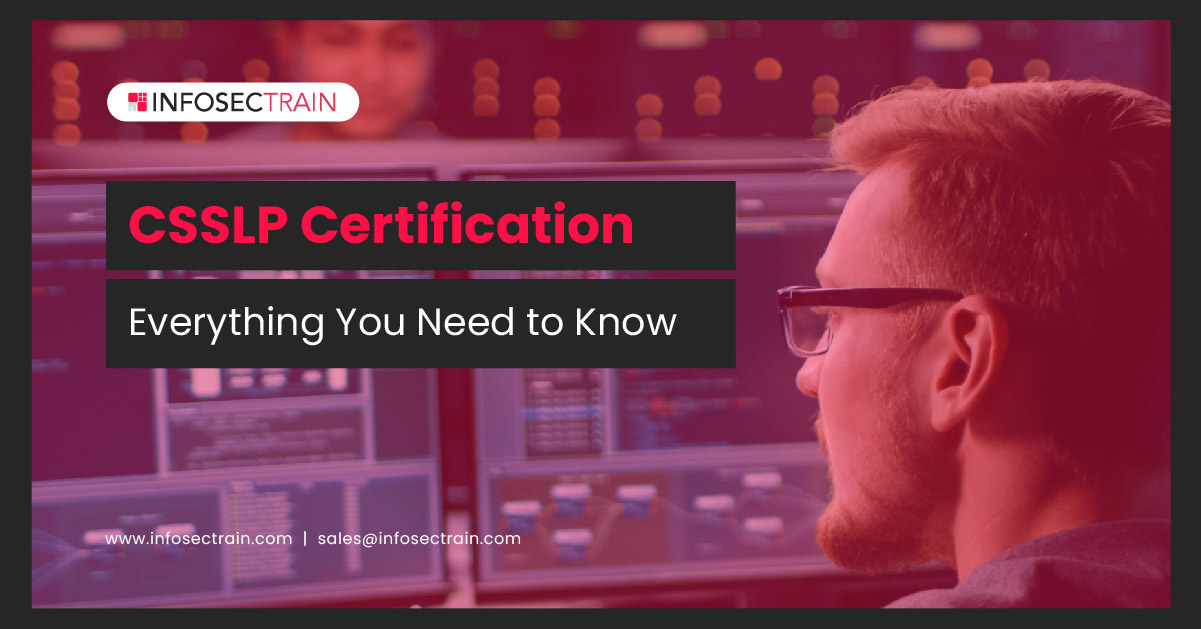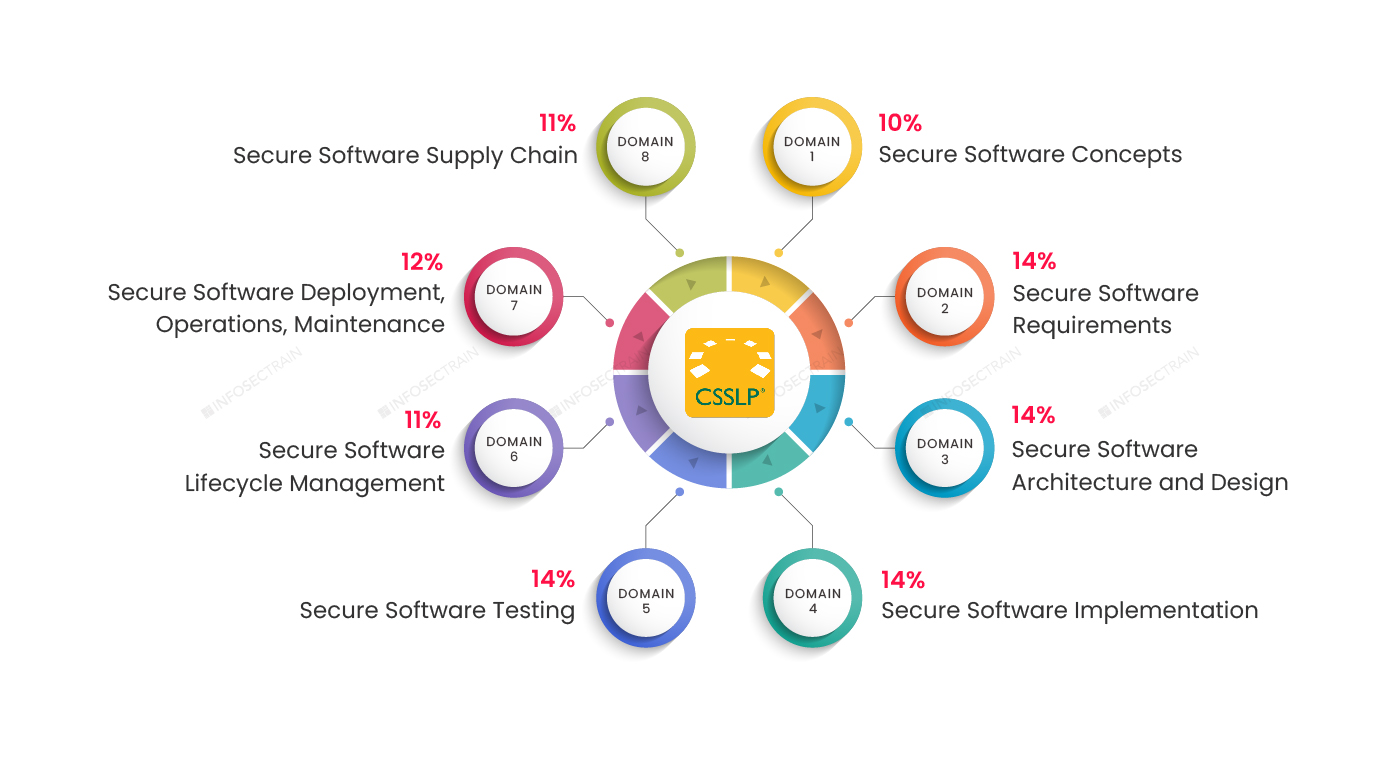CSSLP Certification: Everything You Need to Know

Table of Contents
What is CSSLP Certification?
Benefits of CSSLP Certification
Prerequisites
CSSLP Exam Details
CSSLP Domains
What is CSSLP Certification?
(ISC)2 or International Information System Security Certification Consortium launched the Certified Secure Software Lifecycle Professional (CSSLP) certification in 2008. It is a vendor-neutral credential. The CSSLP certification verifies that the certified professional can apply best security practices, auditing, and authorization to all phases of the SDLC or the Software Development Lifecycle. Software design, implementation, testing, and deployment are all phases of the SDLC. A software professional who has earned their CSSLP certification will establish a software security program for their corporation, reduce the cost of production, mitigate source code vulnerabilities, and reduce losses due to software infringements.
Benefits of CSSLP Certification
CSSLP certification verifies that a person is knowledgeable about software security. It proves that they have the capabilities that companies all across the world are looking for. After completing the CSSLP certification, you can achieve these positions
- Application Security Analyst
- IT Director/Manager
- Software Architect
- Software Developer
- Software Procurement Analyst
- Software Program Manager
CSSLP-certified professionals enjoy lots of benefits, including
- Immediate credibility: CSSLP certification affirms that a person is knowledgeable about software security. It illustrates that they have the skills that organizations worldwide are looking for.
- Increased salary: CSSLP-certified professionals are in high demand in the software security industry. Due to the apparent growing needs, certified professionals earn higher salaries.
- Pertinent knowledge: The CSSLP certification, in addition to certifying one’s expertise, is the best way to broaden one’s software security knowledge. Because (ISC)2 provides continuing education for its CSSLP exam, certified professionals will be able to keep their knowledge relevant and updated by taking (ISC)2
- Adaptable skills: Certified professionals will be able to apply their knowledge and skills to various methodologies and technologies because CSSLP is not product-specific.
- Better protection to the organization: CSSLP professionals can improve the security of their organization’s software products. Furthermore, a CSSLP expert can safeguard personal and private data from internal and external cyber security threats.
Prerequisites
- A candidate is required to have a minimum of four years of cumulative paid Software Development Lifecycle (SDLC) professional work experience in one or more of the eight domains of the (ISC)2 CSSLP CBK.
- Three years of cumulative paid SDLC professional work experience in one or more of the eight domains of the CSSLP CBK with a four-year degree leading to a Baccalaureate, or regional equivalent in Computer Science, Information Technology (IT), or related fields.
CSSLP Exam Details
| Exam Duration | 3 hours |
| Number of Questions | 125 |
| Exam Format | Multiple-choice |
| Passing Score | 700 out of 1000 |
| Language | English |
CSSLP Domains
Here are the CSSLP domains:

Domain 1: Secure Software Concepts (10%)
This domain of CSSLP contains 10% exam weightage. Domain 1 of CSSLP covers the core concepts of security, which include:
- Confidentiality, availability, integrity, authorization, authentication, accountability, and nonrepudiation
- It also covers the security design principles, including separation of duties, defense in depth, resiliency, the economy of mechanism, component rescue, diversity of defense, and so on.
Domain 2: Secure Software Requirements (14%)
CSSLP domain 2 contains 14% weightage in the CSSLP certification exam.
- This domain familiarizes you with functional and non-functional security requirements and also identifies and analyzes the compliance requirements.
- You will understand the concept of data classification requirements (data ownership, labeling, data life-cycle, and types of data) and know the privacy requirements, including data anonymization, user consent, disposition, data retention, cross-borders, and so on.
- You will understand the cases of misuse and abuse, Security Requirements Traceability Matrix (SRTM), etc.
Domain 3: Secure Software Architecture and Design (14%)
CSSLP domain 3 contains 14% weightage in the exam. It emphasizes the necessity of integrating security into software and secure design concepts and how to implement them into software design. It introduces you to several software architectures and explains the security benefits of each.
Domain 4: Secure Software Implementation (14%)
Domain 4 contains 14%weightage in the exam. This domain gives you detailed declarative versus imperative (programmatic) security, concurrency (e.g., thread safety, database concurrency controls), and output sanitization (e.g., encoding, obfuscation). You will understand error and exception handling, input validation, secure logging and auditing, and session management. It also covers vulnerability databases, the Top 10 of the Open Web Application Security Project (OWASP), and Dynamic Application Security Testing (DAST).
Domain 5: Secure Software Testing (14%)
This domain also contains 14% weightage in the exam. This domain is well-versed in creating security test cases, methods, and objectives. It also shows you how to validate and verify documentation (such as installation and setup instructions, user guides, error messages, and release notes), analyze ramifications of test results (such as the impact on product management, optimization, and break build criteria), and conduct validation and confirmation testing.
Domain 6: Secure Software Lifecycle Management (11%)
This domain of CSSLP contains 11% weightage in the exam. It explains how to manage security as part of software development and documentation. It also demonstrates how to create security metrics (e.g., defects per line of code, criticality level, average remediation time, and complexity).
Domain 7: Secure Software Deployment, Operations, Maintenance (12%)
This domain of CSSLP contains a 12% weightage of the exam. This domain covers operational risk analysis, securely releasing software, handling security data, and maintaining Information security Continuous Monitoring (ISCM). It teaches how to do patch management (e.g., secure release, testing) and vulnerability management (e.g., scanning, tracking, triaging).
Domain 8: Secure Software Supply Chain (11%)
This domain contains 11% exam weightage. It describes how to control software supply chain risk and assess third-party software security, and it also explains how to meet supplier security standards during the procurement process.
CSSLP with InfosecTrain
If you’ve decided to take your career to the next level, InfosecTrain’s CSSLP certification training course can assist you. In this course, you will gain professional knowledge and a thorough understanding of the Software Development Life Cycle. Highly qualified and experienced trainers will conduct the training. The CSSLP certification training courses will help you improve your skills and advance your software development security career.







 1800-843-7890 (India)
1800-843-7890 (India)